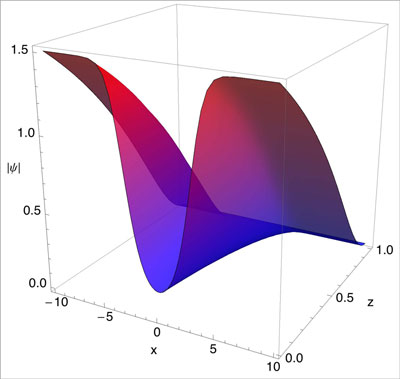| Jun 10, 2011 |
Physicists demonstrate that the Josephson junction could be reproduced
|
|
(Nanowerk News) In recent years, UC Santa Barbara scientists showed that they could reproduce a basic superconductor using Einstein's general theory of relativity. Now, using the same theory, they have demonstrated that the Josephson junction could be reproduced. The results are explained in a recent issue of the journal Physical Review Letters.
|
|
The Josephson junction, a device that was first discovered by Brian David Josephson in the early 1960's, is a main ingredient in applications of superconductivity.
|
|
Gary Horowitz, professor of physics at UCSB, said that Einstein's general theory of relativity -- which was developed as a theory of gravity and is extremely successful in explaining a wide variety of gravitational phenomena -- is now being used to explain several aspects of non-gravitational physics.
|
 |
| The gravitational description of the superconducting condensate shows a suppression in the gap. (Credit: Jorge Santos, UCSB)
|
|
"The basic phenomenon with Josephson junctions is that you can take two superconductors, separate them by a little gap, and still find current going across it, in a specific way," said Horowitz. "And that has found many applications. So the Josephson junction is something we've reproduced using general relativity."
|
|
Horowitz said that he and his co-authors used tools from string theory to develop the gravity model of a superconductor. He explained that it was surprising to be able to link Einstein's general theory of relativity to a totally different area of physics. He said he hoped that the new tools would one day be able to shed light on new types of superconductors.
|
|
"Most materials, if you cool them down sufficiently, will actually conduct electricity without any resistance," said Horowitz. "These are superconductors. There is a standard theory of superconductivity, discovered about 50 years ago, that has worked well for most of the so-called conventional superconductors."
|
|
A new class of materials was discovered 25 years ago. These are superconductors that have zero resistance at somewhat higher temperatures. Physicists are still working on understanding the mechanism.
|
|
This new class of materials involves copper-oxygen planes. Another new class of superconductors, based on iron instead of copper, was discovered a couple of years ago. These materials, called iron nictides, also have the property of superconducting at a higher temperature.
|
|
"There is a lot of activity and interest in understanding these materials," said Horowitz. "Ultimately, the goal is to have a room-temperature superconductor, which, you can imagine, would have lots of interesting applications."
|
|
Horowitz and his research team found what could be called a gravitational model, or a gravitational dual -- a dual description of a superconductor using gravity, black holes, and all of the traditional ingredients of general relativity. "This came as quite a surprise because this is a totally different area of physics, which is now being connected to this condensed matter area," said Horowitz.
|

